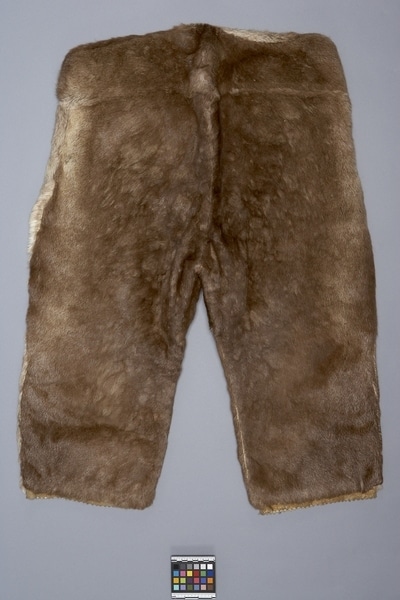Pants Item Number: A2.565 b from the MOA: University of British Columbia


Description
Men's outer trousers made of caribou skin with thick fur (part b). The trousers reach to just below the knee. There is a broad casing on the top with a piece of rope for a drawstring. The trousers have a fly in the front that can be closed by tying two pairs of leather straps. The legs are trimmed with a band of hairless skin sewn to the inside. Two white bands of cloth are attached to the top forming loops.
History Of Use
Men wore two layers of trousers in winter. The trousers have a high waist because of The insulating capability of animal skins is enhanced by the practice of wearing two layers of skin clothing, especially in winter. One layer of clothing is worn with the fur on the inside and a second layer is worn with the fur on the outside. The clothing also is designed so as to minimize ingress of wind and cold. During winter men and women wear two hooded waist-length coats, two pairs of trousers, two pairs of stockings and boots, and mittens. Men often wear a longer, heavier outer coat when outdoors in winter. While mass-produced clothing from the south is now commonly worn, the making of skin clothing is being revived in the Arctic.
In the Arctic, the making of clothing is considered as important as the creation of sacred objects. Aside from its important function as protection against the cold, clothing is imbued with power and spirituality. Women as seamstresses play an extremely important role in the expression of cultural value and meaning. The clothing of each group is cut and decorated according to distinctive cultural aesthetics. In addition to expressing the group’s identity, seamstresses express the beliefs and values of the group through clothing, which marks social identities like gender, age, childbearing status, and geographical origin. Clothing also expresses the special relationship of people in the Arctic with the animal world. People, animals, and spirits are subject to metamorphosis. Clothing often refers to this ability to transform, and could effect such a metamorphosis.
the short length of the front of the coat.
Cultural Context
clothing
Specific Techniques
The pieces are sewn together with an overcast stitch on the fur side.
Item History
- Made in Coppermine, Nunavut, Canada and Kugluktuk, Nunavut, Canada
- Owned by Howard Roloff before March 2, 1973
- Received from Howard Roloff (Donor) on March 2, 1973
What
- Name
- Pants
- Identification Number
- A2.565 b
- Type of Item
- pant
- Material
- cotton fibre, fibre and caribou skin
- Manufacturing Technique
- cut, pieced, sewn and strung
- Overall
- height 13.0 cm, width 91.5 cm, depth 76.0 cm
Who
- Culture
- Inuit: Inuinnait
- Previous Owner
- Howard Roloff
- Received from
- Howard Roloff (Donor)
Where
- Holding Institution
- MOA: University of British Columbia
- Made in
- Coppermine, Nunavut, Canada and Kugluktuk, Nunavut, Canada
When
- Ownership Date
- before March 2, 1973
- Acquisition Date
- on March 2, 1973
Other
- Item Classes
- textiles
- Condition
- good
- Accession Number
- 1807/0002 b